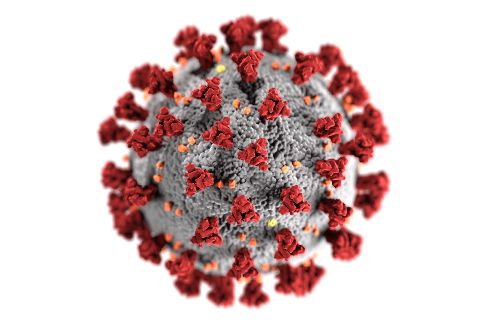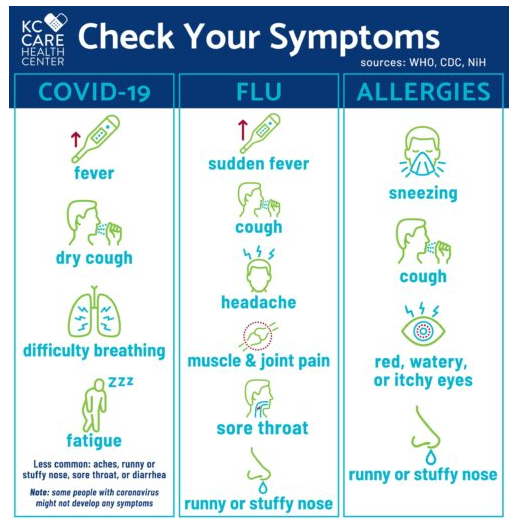
As updates regarding Coronavirus (COVID-19) spread across the globe, Kansas City has taken precautionary measures to prevent the mass spread of the virus across the city.
On Thursday, March 12, Kansas City Mayor Quinton Lucas declared a state of emergency for Kansas City for the next 21 days as the City works to prevent the spread of COVID-19.
What are health providers in the Kansas City area saying about the virus, the spread, and how individuals in Kansas City can protect themselves?
We spoke with Chief Medical Officer Dr. Craig Dietz at KC CARE Health Center as well as Dr. Darrin D’Agostino, executive dean of the College of Osteopathic Medicine and vice president for Health Affairs at Kansas City University, to discuss what COVID-19 looks like in our community.
What is COVID-19?
Coronaviruses are a family of viruses that typically attack an individual’s respiratory system.
COVID-19 is the name the World Health Organization gave to the novel (new) coronavirus that was first seen in Wuhan, China. ‘CO’ stands for ‘corona,’ ‘VI’ stands for ‘virus,’ ‘D’ for ‘disease,’ and ‘19’ for the year.
There are currently seven known coronaviruses that can infect humans and were first identified in the mid-1960s.
According to the World Health Organization, coronaviruses (CoV) are a “large family of viruses that cause illness ranging from the common cold to more severe diseases” such as MERS-CoV (the beta coronavirus that causes Middle East Respiratory Syndrome, or MERS) and SARS-CoV (the beta coronavirus that causes severe acute respiratory syndrome, or SARS).
The name ‘coronavirus’ comes from the crown-like (corona) spikes on the surface of the virus.
A novel coronavirus, like COVID-19 are new coronaviruses that have not been identified.
Where did it come from?
Most reports link COVID-19 to a wet market in Wuhan, China. Out of the first few dozen patients, the majority of them had been to the market, prompting the closure of the market.
In these wet markets, animals of varying species, including wildlife, are placed in close proximity to one another and often on stacked cages. A larger population of varying types of animals increases the chances of a sick animal spreading disease.
With the COVID-19 virus, there are reports that indicate that the virus moved from a bat to a pangolin before infecting a human, most likely through the handling process as animals are slaughtered on-site.
What are the symptoms?
The symptoms of COVID-19 are fever, cough, and shortness of breath which range in severity.

Who is most at risk?
According to the CDC, older adults, and people who have serious chronic medical conditions like heart disease, diabetes, and lung disease are most at risk.
“The people who are most at risk are the elderly who have chronic conditions, such as lung problems and lung disease, chronic smokers are at risk, diabetes, and heart disease,” said Dr. D’Agostino. “The reality is that it’s mostly in the older populations is where the risk is.
How does COVID-19 differ from the flu?
Flu symptoms include nausea, muscle ache, vomiting, and diarrhea, which Coronaviruses typically do not cause.
Dr. D’Agostino said the flu is a “very significant” and “dangerous” virus. According to the Center for Disease Control (CDC), there have been 36,000,000 – 51,000,000 flu illnesses and 22,000 – 55,000 flu deaths during the 2019-2020 flu season.
The CDC also estimates that during the 2018–2019 season, an estimated 35.5 million people were sick with the flu, there were 490,600 hospitalizations and 34,200 deaths.
“With influenza, we’ve had it so long and we have learned that it’s part of our life,” said Dr. D’Agostino. “When the flu season comes around, we have to get a vaccine. We gave out 174.1 million vaccines for flu this year and yet, with all those vaccines, we still have thousands of deaths. Flu is a very significant disease that we should be focused on every year. It comes back every year.”
The difference, he said, is education.
“We want to make sure everybody has the right information so they can make the right judgments about what they are planning on doing. There has been a lot of misinformation out in the media.”
What is a novel virus?
According to the CDC, a “novel coronavirus is a new coronavirus that has not been previously identified. The virus causing coronavirus disease 2019 (COVID-19), is not the same as the coronaviruses that commonly circulate among humans and cause mild illness, like the common cold.”
Dr. D’Agostino said while humans have never been infected with this specific Coronavirus before, the majority of those infected can recover.
“We’ve never had this in the human population so there’s no native immunity,” he said. “When that information was released, people thought they were automatically going to be at risk. Really what it means is that the virus got into us and although we didn’t have native immunity or a specific immunity for it, we have our own immune system that ramps up and protects it. The virus itself is in the family of coronaviruses. The other coronaviruses we have that come to us, except SARS and MERS, the other coronaviruses, actually give us the common cold. We get them every year. All of us have had them if we have ever had a cold. The new one, because it’s so novel, what we are learning is that it is pretty aggressive in the older population, but even the normal coronaviruses can do that to an older person. All of these things put together have made it a bit scary.”
How does COVID-19 spread?
COVID-19 spreads mainly through respiratory droplets a person emits when they sneeze or cough. The virus can also live on surfaces, so if a person touches a surface that has the virus on it and then touches their eyes, nose, or mouth, they can be infected.
If a person is sick, wearing a mask can help prevent the spread of the Coronavirus, but if you are not sick, wearing a mask has not been proven to prevent contraction of the virus.
How can you protect yourself?
There is currently no vaccine for COVID-19. According to the CDC, the best way to prevent infection is to wash your hands, avoid close contact with people, and stay home if you feel sick to avoid spreading illness to others.
Both Dr. D’Agostino and Dr. Dietz said handwashing was the number one preventative measure.
“Everybody is pulling all these chemicals off the shelves, but really soap and water works well and we recommend soap and water over everything else,” said Dr. D’Agostino. “Handwashing for 20 seconds and cleaning clothes with normal detergents are fine. There is this hyper fear of the germs that are out there but the reality is that the things that we need to do are stay calm, understand what our risks are, and use the common things that we have that work well.”
Are COVID-19 tests available?
According to Dr. D’Agostino, the CDC has produced a polymerase chain reaction (PCR) test which looks for the RNA of the genetic material of the virus to see if a person has been infected through a mouth swab or a nose swab.
Both Missouri and Kansas have received tests, but they are in limited supply. Dr. D’Agostino said healthcare providers have been assured by the government that the distribution of more tests will occur by the end of this week.
How is COVID-19 being treated?
There is currently no vaccine for COVID-19.
Dr. D’Agostino said most individuals, if after being evaluated and assessed to be healthy enough, can recover at home.
“If someone does test positive, they are going to activate the public health system, be assessed, to determine if you can be sent home. If symptoms are severe, they are isolated in the hospital and given supportive care.”
For more severe cases, such as having difficulty breathing, both doctors suggest calling an urgent care facility to let them know your symptoms and visit the ER.
“For most people, you can treat it like a bad common cold, take what you would normally take at the drugstores,” said Dr. Dietz.
How does this affect uninsured or underinsured individuals?
Dr. Dietz with KC CARE Health Center, which provides care to those who are underinsured or uninsured, said the main issue right now is with the availability of testing.
“Testing isn’t free quite yet,” he said. “That may change within the next week or two as we get more information.”
Once more COVID-19 tests are available to the public, Dr. Dietz said he is unsure whether the tests will be free or what dollar amount individuals who are underinsured or uninsured will have to pay.
What are some measures Kansas City is taking to reduce the spread of COVID-19?
- Mayor Lucas declared a state of emergency for the city, canceling all events that will draw crowds of 1,000 people or more.
- Sporting KC matches have been suspended.
- Schools have closed, including Kansas City Public Schools, Scuola Vita Nuova Charter School, Frontier Schools, Guadalupe Centers, and the Kansas City Girls Preparatory Academy.
- The Kansas City Public Library has canceled events and programs through March 31.
- The Big 12 Tournament has been canceled.
- The Jackson County Board of Equalization hearings will be held by phone only.
- The annual St. Patrick’s Day Parade has been canceled.
- The Nelson-Atkins Museum of Art will be closed until April 3.
- Colleges and Universities have moved to online learning/classes.
- Planet Comicon has been postponed.
What is important to remember?
Dr. D’Agostino said it is imperative to remember that a pandemic does not equal lethality.
According to the World Health Organization, a “pandemic is declared when a new disease for which people do not have immunity spreads around the world beyond expectations” and is used to discuss concerns over geographical spread.
“Just because it’s a pandemic doesn’t mean its the worse virus that’s ever existed,” said Dr. D’Agostino. “What it means is that we have a virus that has spread around the globe and is of sufficient numbers now of infected people that we have to worry that the spread is going to continue. Although the medical community is using words that may sound ominous, they actually have a meaning to describe what’s going on, not necessarily to describe how bad it is. The best thing people can do is to stay calm and ask questions.”
Where can you go for more information?
Visit the CDC’s website, KC CARE Health Center’s recent blog, or call the Missouri Department of Health and Senior Services statewide public hotline (operated by medical professionals) at 877-435-8411.


















